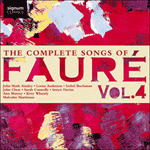Here is Fauré attempting to find a style that is suitably profound for this very serious poem of Baudelaire. The composer had high hopes for this setting as is shown by its dedication to Henri Duparc, the only French composer who has truly got to the heart of that elusive poet. The first two strophes are set in Fauré’s solemn style (the song it most resembles is
Seule!), the words engraved on stone like a classical pronouncement, with just a hint of contrapuntal commentary in the piano. After the word ‘arrose’ this parched music is watered and melts from static crotchets into quavers, from flats into the naturals of major key. This is only the first stage of resuscitation; after the word ‘Amour’ the tempo quickens (un poco più mosso); the accompaniment takes on a quasi philosophical, lieder-like quality, as if the song were by César Franck, or Schumann–Brahms at one remove. This pianistic style – rambling arpeggios and uncharacteristic acciacaturas – attempts to plumb new depths, but in vain. The music is not without interest or beauty (at the mention of angels at the end of the song we hear a distant prophecy of
Une sainte en son auréole from
La bonne chanson) but it never achieves unity with Baudelaire’s text.
from notes by Graham Johnson © 2005
Ici, Fauré tente de trouver un style d’une profondeur en phase avec ce très sérieux poème de Baudelaire. Si l’on en juge par la dédicace à Henri Duparc—le seul compositeur français à être allé vraiment au coeur de ce poète insaisissable—, il fondait de grands espoirs sur cette pièce. Les deux premières strophes sont mises en musique dans son style solennel (
Seule! est la mélodie à laquelle cette pièce ressemble le plus) : les mots sont gravés dans la pierre, comme dans une déclamation classique avec juste une pointe de commentaire contrapuntique au piano. Après « arrose », cette musique desséchée est abreuvée et passe des noires statiques aux croches, des bémols aux bécarres de la tonalité majeure. Ce n’est là que la première phase de la résurrection ; passé le mot « amour », le tempo s’accélère (un poco più mosso) et l’accompagnement prend une tournure quasi philosophique, de type lied, comme si cette mélodie était de César Franck, voire de Schumann-Brahms. Ce style pianistique (arpèges futiles et acciacatures falotes) tente d’atteindre de nouvelles profondeurs, mais en vain. Cette musique n’est pas sans intérêt, pas sans beauté non plus (à la mention des anges, à la fin, on entend une lointaine préfiguration d’
Une sainte en son auréole, extraite de
La bonne chanson), mais jamais elle ne parvient à ne faire qu’un avec le texte de Baudelaire.
extrait des notes rédigées par Graham Johnson © 2005
Français: Hypérion


 Fauré: The Complete Songs, Vol. 4
Fauré: The Complete Songs, Vol. 4
